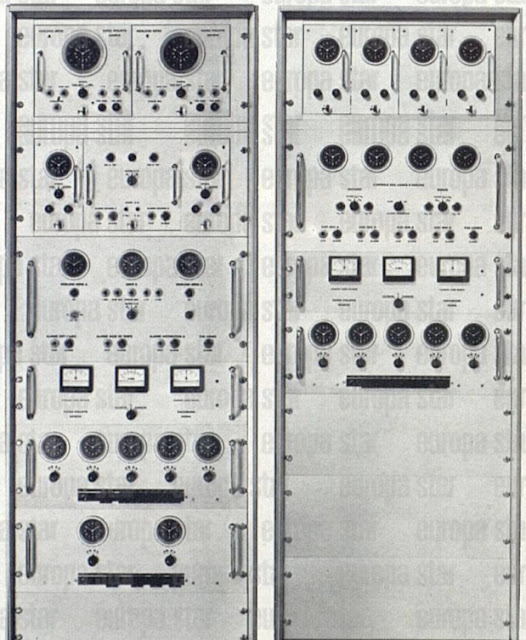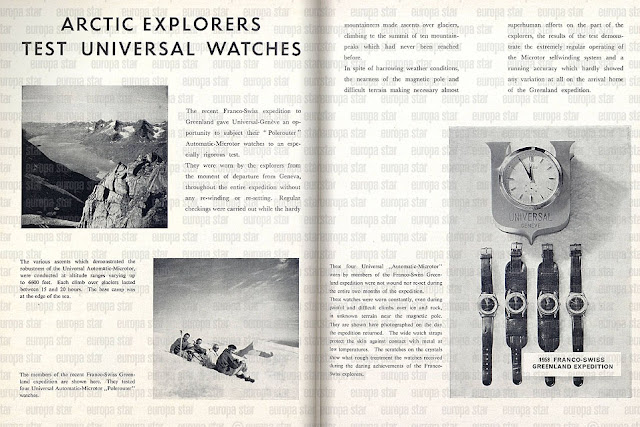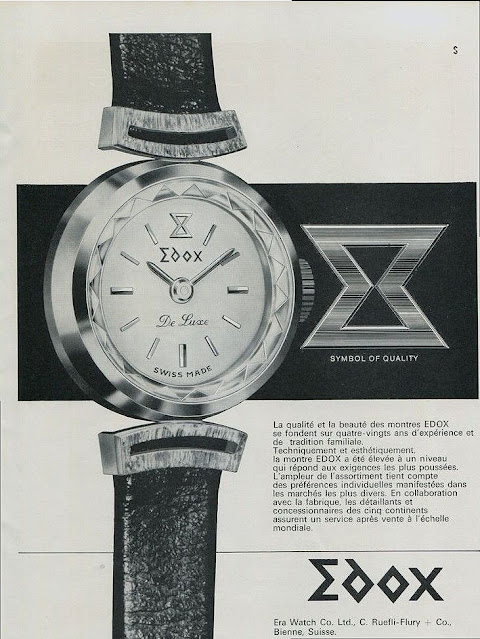By Bruce Shawkey
Thursday, June 29, 2023
Bulova Made a Mechanical Ships/Airplane Chronometers
By Bruce Shawkey
Did you know Bulova made a mechanical ships' and airplane chronometers? This is from a 1967 issue of Europa Star magazine. By this time Bulova had developed the Accutron, both the 214 and 218, both more accurate than a mechanical chronometer. I guess ships' captains preferred the traditional timekkeeper:
Keeping Time at the Vatican
By Bruce Shawkey
Found this interest article in a 1967 issue of Europa Star Magazine:
Crowns, Springbars and, Yes, Pocketwatch Bows in 1967
By Bruce Shawkey
Crowns, Springbars and, Yes, Pocketwatch Bows in 1967
Every month, this factory makes 1,800,000 spring bars. That's 21,600,000 spring bars a year. In addition, the factory makes 800,000 pocketwatch bows every month. This is in 1967, by which time time pocketwatches were a quaint product of the early 20th century!
Here's some more information on Pibor's output:
Wednesday, June 28, 2023
Universal Geneve
By Bruce Shawkey
Universal Genève SA is a Swiss luxury watch company, founded in 1894 as Universal Watch. Since its beginnings, the company has produced complete watches with in-house movements. Along with neighboring Geneva companies Audemars Piguet, Girard-Perregaux, Patek Philippe and Rolex, Universal is internationally regarded for its style of craftsmanship as a manufacture d'horlogerie. Universal Genève is known for creating the first-ever chronograph in 1917.
Started and briefly based in Le Locle, co-founder Ulysse Perret would relocate Universal to Geneva in 1919, solidifying the company's status as a Genève brand. During the company's tenure in much smaller Le Locle (Neuchâtel region), Perret had conceptualized the company as Universal Watch in 1894 with classmate Numa-Emile Descombes, both of whom were horology students at the time. Although Universal began only as a manufacturer and retailer of cases, crowns, dials and movements, the company whilst under Perret and Descombes patented the brand's first 24-hour indication watch.
After Descombes' death in 1897 at the age of 34, Perret recruited Louis Edouard Berthoud as a co-manufacturer of complications,[2] and both briefly operated under the registered name Perret & Berthoud before switching to Universal Watch et Company (UWEC) Genève, Ltd. after relocating to Geneva. Under both trademarks, the horologists created various pocket and trench watches for both sides during World War I By 1925, the duo created the brand's first patented self-winding timepiece called the Auto Rem, an octagon-shaped men's wristwatch with lozenge-styled hands and a 15-jewel movement.
Following Perret's passing in 1933, his son would take over management, and Universal would remain a family-run business for 30 more years.
The Tri-Compax Chronograph
After the pocketwatch started to lose usefulness in favor of the more convenient wristwatch during the first world war, Universal seized the opportunity by creating the Compur in 1933 and the Aero Compax ("Aviator's Compact Chronograph") in 1936,[5] shortly before the start of World War II. In addition to its automatic "smooth sweep" timekeeping, the Compax was also equipped with a built-in stopwatch which made it a suitable device for soldiers during training exercises and full-fledged combat operations. The Compax was produced in many variations including the Moon Phase, Medico, Tri-, Uni-, and Master Vortex.
During the same period, Universal briefly collaborated with Parisian high fashion brand Hermès and designed the Pour Hermès ("For Hermès") chronographs, which featured square button registers, telemeters and tachometers, a movement containing a Breguet balance spring, and an Arabic-numeral dial. Hermès' Paris headquarters would in turn act as a major sales hub for all Universal brand watches in Europe until the 1950s, while the Henri Stern Watch Agency in Manhattan, the U.S. distributorship of Patek Philippe, would be an official Universal Genève dealer in North America.
Universal's popularity with the chronographs caught the attention of high-ranking government officials throughout Europe, including the Dutch Royal Family, who granted the Swiss brand a Royal Warrant in 1939 to issue a military watch for the nation's army, with then-Queen Wilhelmina's initials embossed on the dial.[8] The Dutch army utilized this watch up until Nazi Germany bombed Rotterdam in May of the same year and occupied the Netherlands until 1945.
Arguably the most well-known Universal watch of the post-war era was the Polerouter. Designed by Gérald Genta, it was originally produced as the Polarouter in 1954, appearing with a Cal 138SS Bumper movement. The following year it was replaced with the innovative Cal 215 microtor movement which, with minor changes and a name change (from Polarouter to Polerouter, in 1955), was produced until late 1969.[11] In its initial fifteen years of production, the watch was produced in many variations including the Polerouter de luxe, Polerouter Jet, Polerouter Super, Polerouter Genève, Polerouter Compact, Polerouter "NS", Polerouter III, and the Polerouter Sub diver's watch. The Polerouter's durability under extreme temperatures and fluctuating altitudes made it a preferred timepiece among Scandinavian Airlines' pilots who made flights over the arctic. The worldwide acclaim of the Polerouter Date was comparable to the reputation of similar Genève automatics like the Rolex Oyster Date and Omega Seamaster Date.
Here are some ads and pictures of Universal Geneve watches over the decades:
 |
| Polerouter electric circa 1965 |
Edox
By Bruce Shawkey
 Montres Edox et Vista SA (EDOX) is a Swiss manufacture of luxury wristwatches that operates under the Era Watch Company. Christian Ruefli-Flury, a watchmaker originating from Grenchen, Switzerland, founded the company in 1884 in Biel/Bienne. Edox has remained in continuous production since their foundation.
Montres Edox et Vista SA (EDOX) is a Swiss manufacture of luxury wristwatches that operates under the Era Watch Company. Christian Ruefli-Flury, a watchmaker originating from Grenchen, Switzerland, founded the company in 1884 in Biel/Bienne. Edox has remained in continuous production since their foundation.
Ruefli-Flury used the ancient Greek word Edox as a trademark, and designed the "1900" hourglass to serve as a visual symbol for the company's brand. Robert Kaufman-Hug took over the company when Ruefli-Flury died in 1921. He led the company's transition from pocket watches to become the first wristwatch-exclusive watchmaker.
By 1955, the company employed 500 people and moved to a new factory. The Delfin line of watches launched in 1961, with industry-first double casebacks for high standards of shock protection, water resistance, and ruggedness. The Hydrosub line was launched in 1963, featuring the first crown system with tension ring, allowing waterproofness of 500 meters. In 1965, Victor Flury-Liechti took over the company from his uncle, and invested in new manufacturing technologies. This led to the 1970 Geoscope timepiece, the first watch covering all time zones. In 1973, the third-generation Delfin was released. It used elements from to the Gerald Genta-designed Audemars Piguet Royal Oak.
With the rise of Japaneses watches and the Quartz Crisis in the 1970s, the company became an affiliate of the General Watch Company, a sub-holding company of ASUAG. As part of the move, Technos and Certina were transferred to the Biel/Bienne Edox location. At the end of the downturn in the Swiss watch industry in 1983, Edox regained independence when the company was sold to Victor Strambini Montres Vista SA and moved to Les Genevez, Jura Mountains. It has since remained a family-owned company. The Edox Les Bémonts Ultra Slim was released in 1998. With a movement thickness of 1.4 mm, it still holds the record for the slimmest calendar watch.
Here are some ads and pictures of Edox watches over the decades:








































































